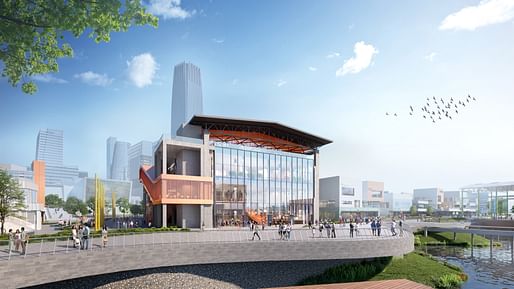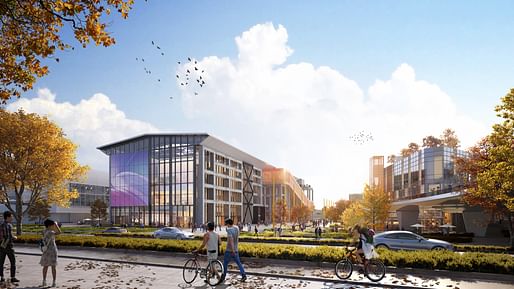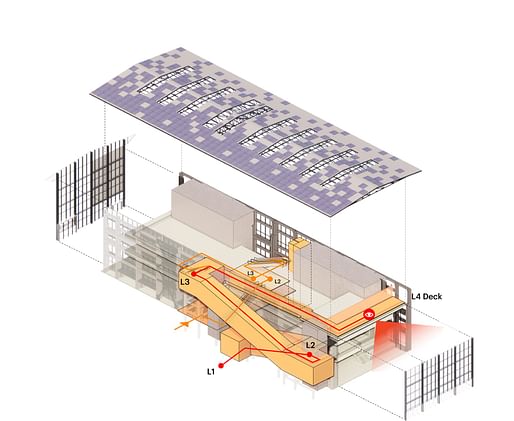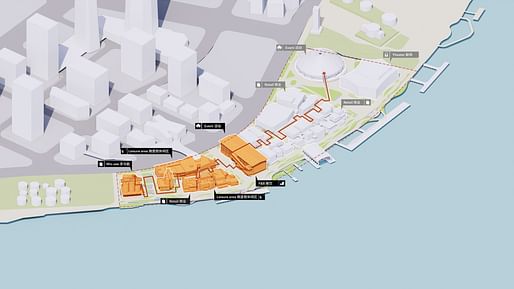
A team led by MVRDV has begun construction on a leisure and cultural district in Shanghai on the site of a disused cement factory. Named Gate M West Bund Dream Center, the project will transform a collection of buildings of different styles and time periods, “adapting a former industrial zone while making use of the existing structures and thus minimizing carbon emissions,” according to the team.

Under the MVRDV scheme, developed with co-architect AISA, landscape architect Field Operations, and interior architects CL3 and Xu Studio, a series of disused buildings will be linked in a “cohesive whole” by a network of bright orange paths, stairs, ramps, and bridges. The site is organized around key landscaped axes including a central spine linking both ends of the district, while a “three-dimensional promenade” is created by a series of landscaped rooftops, elevated riverbank terraces, and a network of staircases and elevators finished in a defining orange color.

Across the site, all existing structures are to be retained and reactivated. According to MVRDV, a light-touch approach is to be taken to more recent structures, including the retention of existing materials where possible. Meanwhile, older industrial buildings will be subject to a more extensive overhaul, “highlighting the industrial heritage and distinguishing between old and new.”

Many industrial buildings on the site will be reimagined as cultural spaces, while newer structures will be converted into hotels, restaurants, cafes, and retail outlets. “In the past, the area was organized around the movement of raw materials for cement production,” the team notes. “In the future, it will enable the free movement of people with just as much efficiency.”

Detailed design of buildings on the northern half of the master plan will be provided by Schmidt Hammer Lassen and Shanghai-based Atelier Deshaus, while MVRDV will design buildings on the southern half of the site, including a former warehouse that will become the district’s central structure, renamed The Dream Center Hall. Once an imposing skeletal structure of concrete frames and a steel truss roof, the building will be renovated with a minimalist glass infill to aid its transformation into a leisure and cultural destination. The lower floors will house retail, cafes, and restaurants, while a large exhibition and event space will occupy the column-free top floor. Meanwhile, a mezzanine within the structure will house a restaurant with a riverside external terrace.

“This project is an excellent demonstration of how the time between a building’s realization and its renovation seems to get shorter and shorter”, said MVRDV founding partner Jacob van Rijs about the scheme. “It used to be that we only transformed culturally significant buildings from earlier time periods; here we transform not only 20th-century industrial heritage but even unfinished buildings from recent years. It goes to show how much value every city has in its existing structures that is ripe for designers to unlock.”

News of the scheme comes weeks after MVRDV won a competition for a cultural center and office scheme in Chengdu, China. Earlier in January, meanwhile, the firm unveiled plans for a new ‘Green Heart’ district in Düsseldorf, Germany.
1 Comment
Contextualised At it's best: recycling urban entities.
Block this user
Are you sure you want to block this user and hide all related comments throughout the site?
Archinect
This is your first comment on Archinect. Your comment will be visible once approved.